Financial Accounting Report: AASB 138/IAS 38 Analysis
VerifiedAdded on 2023/03/20
|10
|3040
|46
Report
AI Summary
This financial accounting report analyzes the significance of intangible asset valuation according to AASB 138/IAS 38, using Technology Limited as a case study. It assesses the company's use of the standard for recognizing expenses and intangible assets in its annual report. The report examines the treatment of research and development costs, the application of fair value accounting, and the impact of the standard's restrictions on comparability. It further explores the relationship between AASB 138/IAS 38 and the efficient market hypothesis. The analysis includes detailed calculations of asset values, consideration of research costs, and a discussion of asset development. The report highlights the importance of accurate financial reporting and disclosure for intangible assets, providing insights into how companies can comply with accounting standards to present a true and fair view of their financial position. The report also discusses the restrictions imposed by AASB 138/IAS 38 to reduce the comparability of financial statements and explains the guidelines for intangible asset valuation.
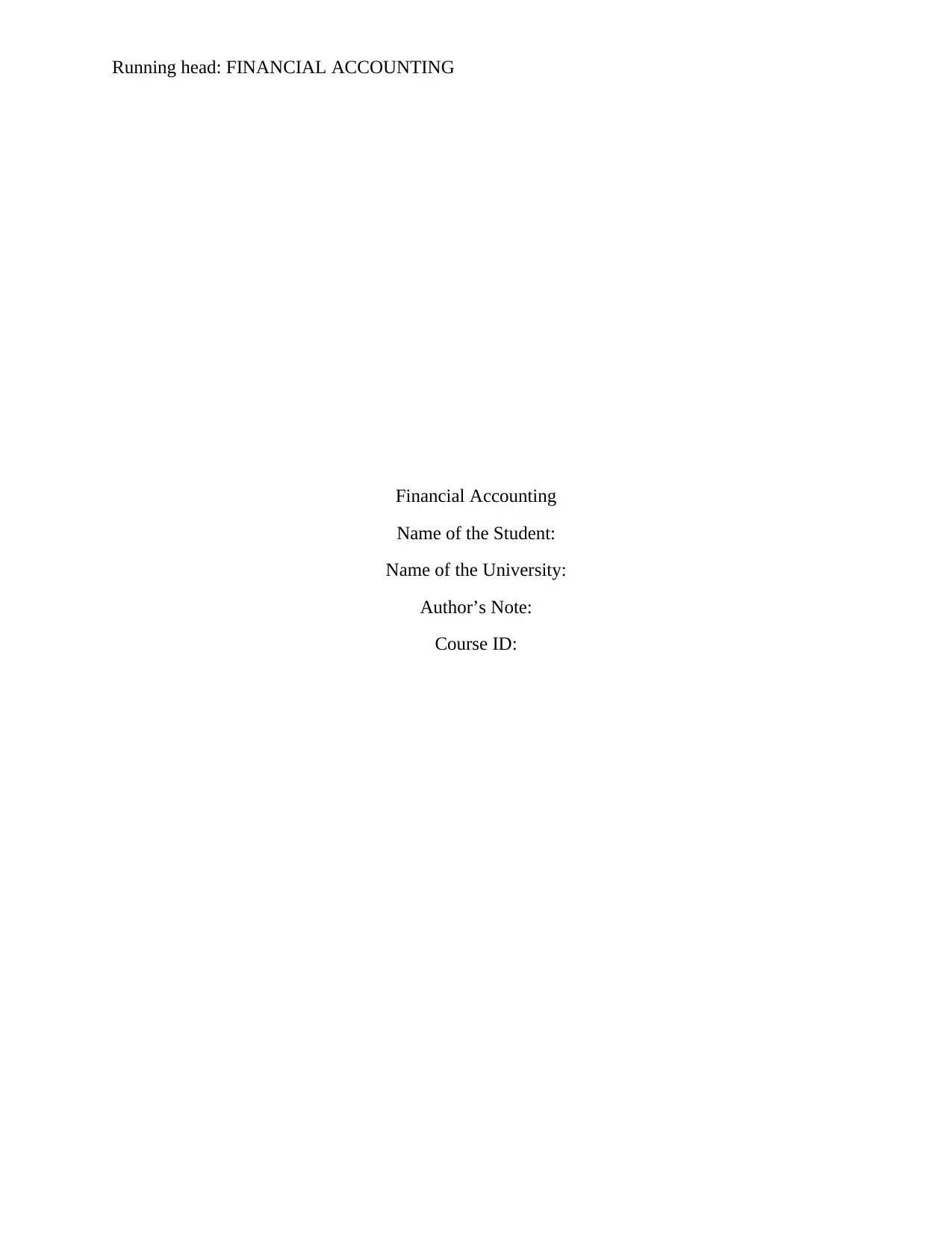
Running head: FINANCIAL ACCOUNTING
Financial Accounting
Name of the Student:
Name of the University:
Author’s Note:
Course ID:
Financial Accounting
Name of the Student:
Name of the University:
Author’s Note:
Course ID:
Paraphrase This Document
Need a fresh take? Get an instant paraphrase of this document with our AI Paraphraser
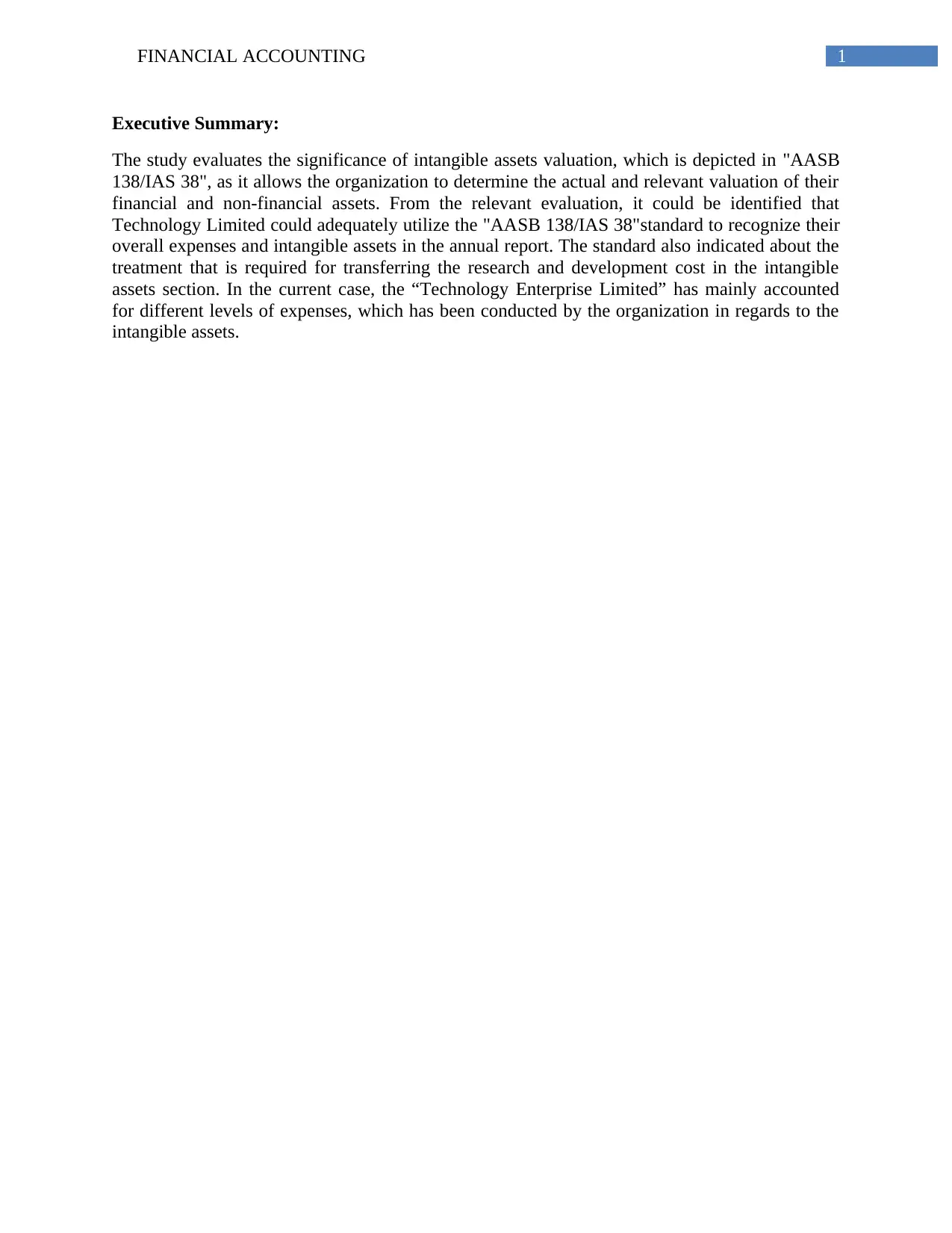
1FINANCIAL ACCOUNTING
Executive Summary:
The study evaluates the significance of intangible assets valuation, which is depicted in "AASB
138/IAS 38", as it allows the organization to determine the actual and relevant valuation of their
financial and non-financial assets. From the relevant evaluation, it could be identified that
Technology Limited could adequately utilize the "AASB 138/IAS 38"standard to recognize their
overall expenses and intangible assets in the annual report. The standard also indicated about the
treatment that is required for transferring the research and development cost in the intangible
assets section. In the current case, the “Technology Enterprise Limited” has mainly accounted
for different levels of expenses, which has been conducted by the organization in regards to the
intangible assets.
Executive Summary:
The study evaluates the significance of intangible assets valuation, which is depicted in "AASB
138/IAS 38", as it allows the organization to determine the actual and relevant valuation of their
financial and non-financial assets. From the relevant evaluation, it could be identified that
Technology Limited could adequately utilize the "AASB 138/IAS 38"standard to recognize their
overall expenses and intangible assets in the annual report. The standard also indicated about the
treatment that is required for transferring the research and development cost in the intangible
assets section. In the current case, the “Technology Enterprise Limited” has mainly accounted
for different levels of expenses, which has been conducted by the organization in regards to the
intangible assets.
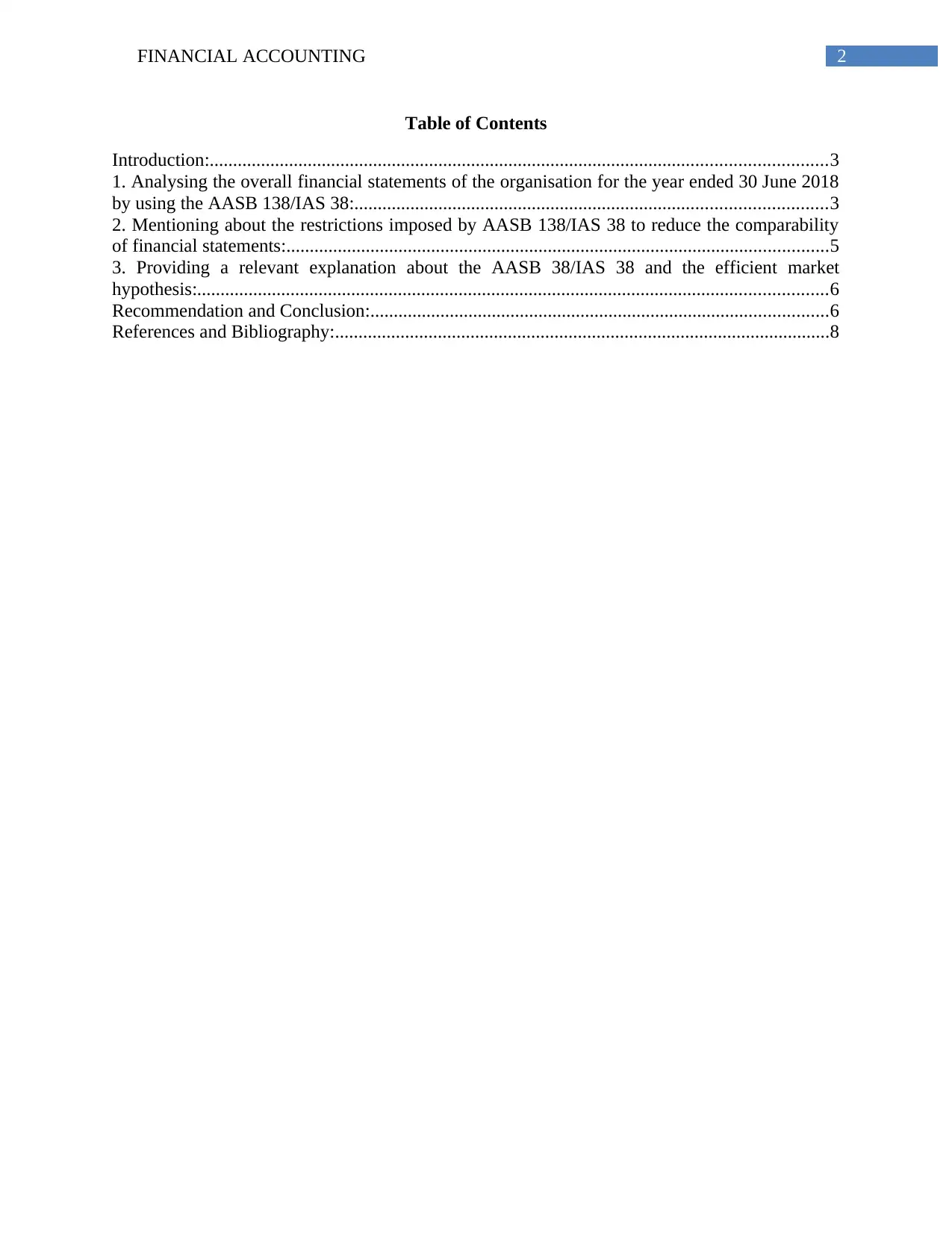
2FINANCIAL ACCOUNTING
Table of Contents
Introduction:....................................................................................................................................3
1. Analysing the overall financial statements of the organisation for the year ended 30 June 2018
by using the AASB 138/IAS 38:.....................................................................................................3
2. Mentioning about the restrictions imposed by AASB 138/IAS 38 to reduce the comparability
of financial statements:....................................................................................................................5
3. Providing a relevant explanation about the AASB 38/IAS 38 and the efficient market
hypothesis:.......................................................................................................................................6
Recommendation and Conclusion:..................................................................................................6
References and Bibliography:..........................................................................................................8
Table of Contents
Introduction:....................................................................................................................................3
1. Analysing the overall financial statements of the organisation for the year ended 30 June 2018
by using the AASB 138/IAS 38:.....................................................................................................3
2. Mentioning about the restrictions imposed by AASB 138/IAS 38 to reduce the comparability
of financial statements:....................................................................................................................5
3. Providing a relevant explanation about the AASB 38/IAS 38 and the efficient market
hypothesis:.......................................................................................................................................6
Recommendation and Conclusion:..................................................................................................6
References and Bibliography:..........................................................................................................8
⊘ This is a preview!⊘
Do you want full access?
Subscribe today to unlock all pages.

Trusted by 1+ million students worldwide
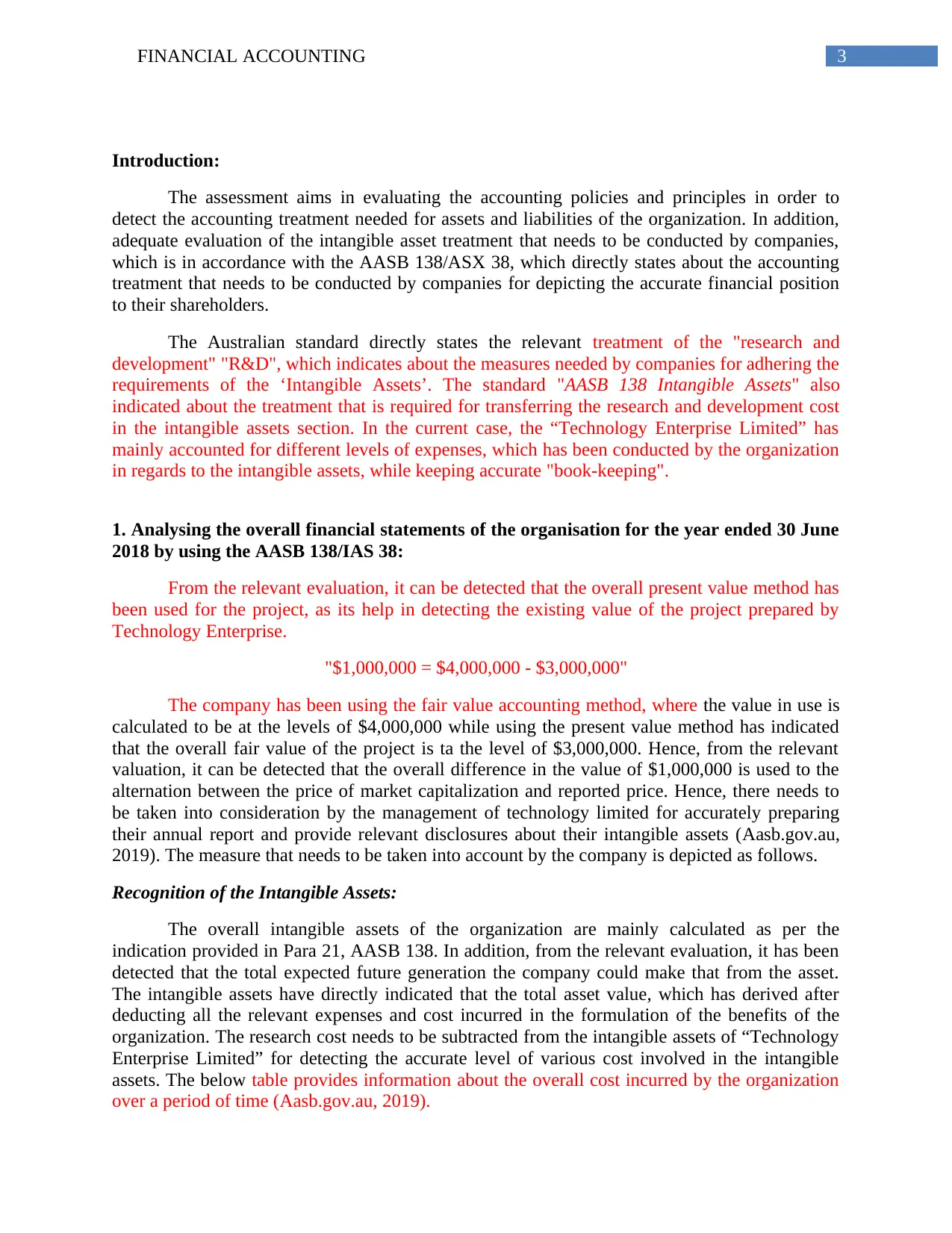
3FINANCIAL ACCOUNTING
Introduction:
The assessment aims in evaluating the accounting policies and principles in order to
detect the accounting treatment needed for assets and liabilities of the organization. In addition,
adequate evaluation of the intangible asset treatment that needs to be conducted by companies,
which is in accordance with the AASB 138/ASX 38, which directly states about the accounting
treatment that needs to be conducted by companies for depicting the accurate financial position
to their shareholders.
The Australian standard directly states the relevant treatment of the "research and
development" "R&D", which indicates about the measures needed by companies for adhering the
requirements of the ‘Intangible Assets’. The standard "AASB 138 Intangible Assets" also
indicated about the treatment that is required for transferring the research and development cost
in the intangible assets section. In the current case, the “Technology Enterprise Limited” has
mainly accounted for different levels of expenses, which has been conducted by the organization
in regards to the intangible assets, while keeping accurate "book-keeping".
1. Analysing the overall financial statements of the organisation for the year ended 30 June
2018 by using the AASB 138/IAS 38:
From the relevant evaluation, it can be detected that the overall present value method has
been used for the project, as its help in detecting the existing value of the project prepared by
Technology Enterprise.
"$1,000,000 = $4,000,000 - $3,000,000"
The company has been using the fair value accounting method, where the value in use is
calculated to be at the levels of $4,000,000 while using the present value method has indicated
that the overall fair value of the project is ta the level of $3,000,000. Hence, from the relevant
valuation, it can be detected that the overall difference in the value of $1,000,000 is used to the
alternation between the price of market capitalization and reported price. Hence, there needs to
be taken into consideration by the management of technology limited for accurately preparing
their annual report and provide relevant disclosures about their intangible assets (Aasb.gov.au,
2019). The measure that needs to be taken into account by the company is depicted as follows.
Recognition of the Intangible Assets:
The overall intangible assets of the organization are mainly calculated as per the
indication provided in Para 21, AASB 138. In addition, from the relevant evaluation, it has been
detected that the total expected future generation the company could make that from the asset.
The intangible assets have directly indicated that the total asset value, which has derived after
deducting all the relevant expenses and cost incurred in the formulation of the benefits of the
organization. The research cost needs to be subtracted from the intangible assets of “Technology
Enterprise Limited” for detecting the accurate level of various cost involved in the intangible
assets. The below table provides information about the overall cost incurred by the organization
over a period of time (Aasb.gov.au, 2019).
Introduction:
The assessment aims in evaluating the accounting policies and principles in order to
detect the accounting treatment needed for assets and liabilities of the organization. In addition,
adequate evaluation of the intangible asset treatment that needs to be conducted by companies,
which is in accordance with the AASB 138/ASX 38, which directly states about the accounting
treatment that needs to be conducted by companies for depicting the accurate financial position
to their shareholders.
The Australian standard directly states the relevant treatment of the "research and
development" "R&D", which indicates about the measures needed by companies for adhering the
requirements of the ‘Intangible Assets’. The standard "AASB 138 Intangible Assets" also
indicated about the treatment that is required for transferring the research and development cost
in the intangible assets section. In the current case, the “Technology Enterprise Limited” has
mainly accounted for different levels of expenses, which has been conducted by the organization
in regards to the intangible assets, while keeping accurate "book-keeping".
1. Analysing the overall financial statements of the organisation for the year ended 30 June
2018 by using the AASB 138/IAS 38:
From the relevant evaluation, it can be detected that the overall present value method has
been used for the project, as its help in detecting the existing value of the project prepared by
Technology Enterprise.
"$1,000,000 = $4,000,000 - $3,000,000"
The company has been using the fair value accounting method, where the value in use is
calculated to be at the levels of $4,000,000 while using the present value method has indicated
that the overall fair value of the project is ta the level of $3,000,000. Hence, from the relevant
valuation, it can be detected that the overall difference in the value of $1,000,000 is used to the
alternation between the price of market capitalization and reported price. Hence, there needs to
be taken into consideration by the management of technology limited for accurately preparing
their annual report and provide relevant disclosures about their intangible assets (Aasb.gov.au,
2019). The measure that needs to be taken into account by the company is depicted as follows.
Recognition of the Intangible Assets:
The overall intangible assets of the organization are mainly calculated as per the
indication provided in Para 21, AASB 138. In addition, from the relevant evaluation, it has been
detected that the total expected future generation the company could make that from the asset.
The intangible assets have directly indicated that the total asset value, which has derived after
deducting all the relevant expenses and cost incurred in the formulation of the benefits of the
organization. The research cost needs to be subtracted from the intangible assets of “Technology
Enterprise Limited” for detecting the accurate level of various cost involved in the intangible
assets. The below table provides information about the overall cost incurred by the organization
over a period of time (Aasb.gov.au, 2019).
Paraphrase This Document
Need a fresh take? Get an instant paraphrase of this document with our AI Paraphraser
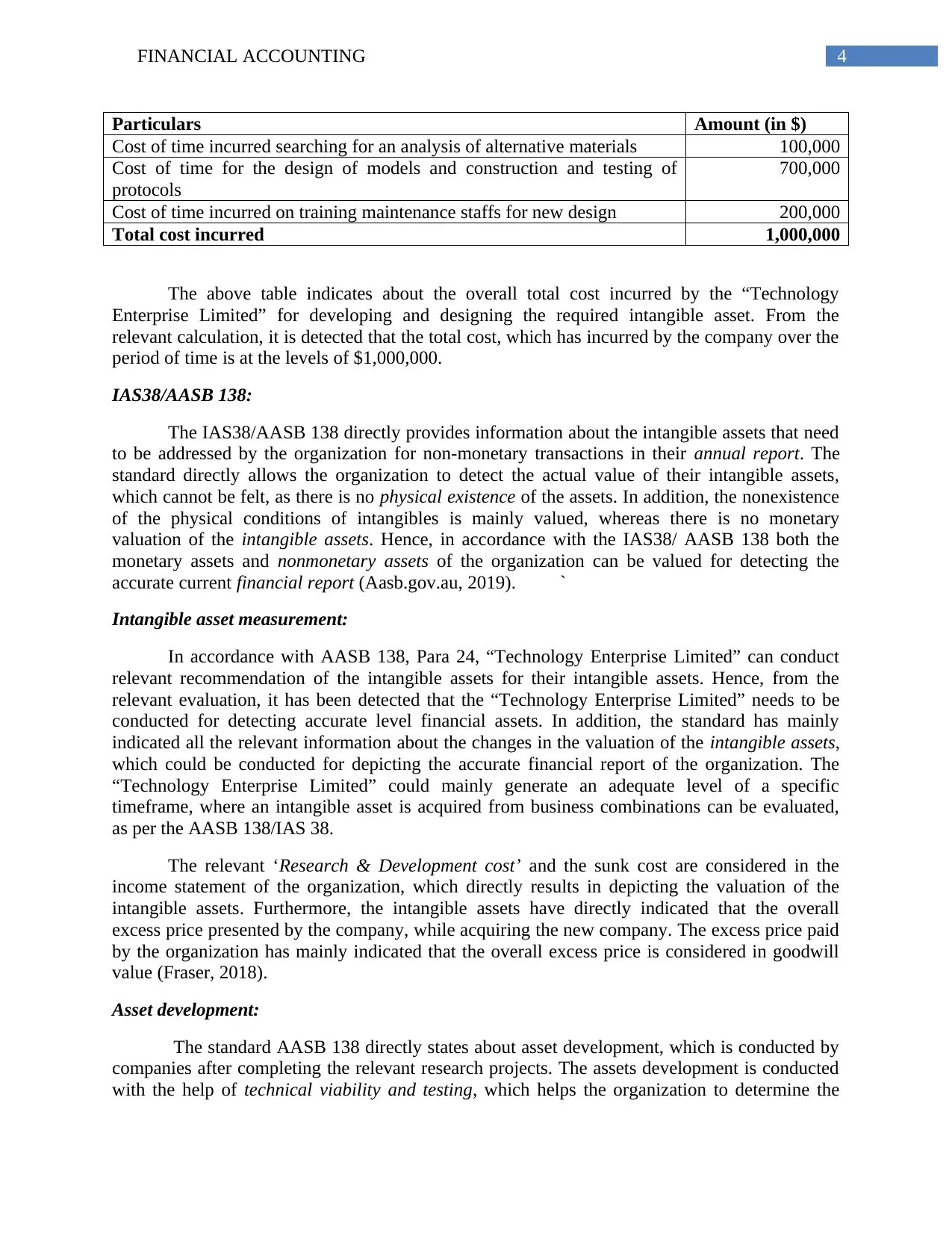
4FINANCIAL ACCOUNTING
Particulars Amount (in $)
Cost of time incurred searching for an analysis of alternative materials 100,000
Cost of time for the design of models and construction and testing of
protocols
700,000
Cost of time incurred on training maintenance staffs for new design 200,000
Total cost incurred 1,000,000
The above table indicates about the overall total cost incurred by the “Technology
Enterprise Limited” for developing and designing the required intangible asset. From the
relevant calculation, it is detected that the total cost, which has incurred by the company over the
period of time is at the levels of $1,000,000.
IAS38/AASB 138:
The IAS38/AASB 138 directly provides information about the intangible assets that need
to be addressed by the organization for non-monetary transactions in their annual report. The
standard directly allows the organization to detect the actual value of their intangible assets,
which cannot be felt, as there is no physical existence of the assets. In addition, the nonexistence
of the physical conditions of intangibles is mainly valued, whereas there is no monetary
valuation of the intangible assets. Hence, in accordance with the IAS38/ AASB 138 both the
monetary assets and nonmonetary assets of the organization can be valued for detecting the
accurate current financial report (Aasb.gov.au, 2019). `
Intangible asset measurement:
In accordance with AASB 138, Para 24, “Technology Enterprise Limited” can conduct
relevant recommendation of the intangible assets for their intangible assets. Hence, from the
relevant evaluation, it has been detected that the “Technology Enterprise Limited” needs to be
conducted for detecting accurate level financial assets. In addition, the standard has mainly
indicated all the relevant information about the changes in the valuation of the intangible assets,
which could be conducted for depicting the accurate financial report of the organization. The
“Technology Enterprise Limited” could mainly generate an adequate level of a specific
timeframe, where an intangible asset is acquired from business combinations can be evaluated,
as per the AASB 138/IAS 38.
The relevant ‘Research & Development cost’ and the sunk cost are considered in the
income statement of the organization, which directly results in depicting the valuation of the
intangible assets. Furthermore, the intangible assets have directly indicated that the overall
excess price presented by the company, while acquiring the new company. The excess price paid
by the organization has mainly indicated that the overall excess price is considered in goodwill
value (Fraser, 2018).
Asset development:
The standard AASB 138 directly states about asset development, which is conducted by
companies after completing the relevant research projects. The assets development is conducted
with the help of technical viability and testing, which helps the organization to determine the
Particulars Amount (in $)
Cost of time incurred searching for an analysis of alternative materials 100,000
Cost of time for the design of models and construction and testing of
protocols
700,000
Cost of time incurred on training maintenance staffs for new design 200,000
Total cost incurred 1,000,000
The above table indicates about the overall total cost incurred by the “Technology
Enterprise Limited” for developing and designing the required intangible asset. From the
relevant calculation, it is detected that the total cost, which has incurred by the company over the
period of time is at the levels of $1,000,000.
IAS38/AASB 138:
The IAS38/AASB 138 directly provides information about the intangible assets that need
to be addressed by the organization for non-monetary transactions in their annual report. The
standard directly allows the organization to detect the actual value of their intangible assets,
which cannot be felt, as there is no physical existence of the assets. In addition, the nonexistence
of the physical conditions of intangibles is mainly valued, whereas there is no monetary
valuation of the intangible assets. Hence, in accordance with the IAS38/ AASB 138 both the
monetary assets and nonmonetary assets of the organization can be valued for detecting the
accurate current financial report (Aasb.gov.au, 2019). `
Intangible asset measurement:
In accordance with AASB 138, Para 24, “Technology Enterprise Limited” can conduct
relevant recommendation of the intangible assets for their intangible assets. Hence, from the
relevant evaluation, it has been detected that the “Technology Enterprise Limited” needs to be
conducted for detecting accurate level financial assets. In addition, the standard has mainly
indicated all the relevant information about the changes in the valuation of the intangible assets,
which could be conducted for depicting the accurate financial report of the organization. The
“Technology Enterprise Limited” could mainly generate an adequate level of a specific
timeframe, where an intangible asset is acquired from business combinations can be evaluated,
as per the AASB 138/IAS 38.
The relevant ‘Research & Development cost’ and the sunk cost are considered in the
income statement of the organization, which directly results in depicting the valuation of the
intangible assets. Furthermore, the intangible assets have directly indicated that the overall
excess price presented by the company, while acquiring the new company. The excess price paid
by the organization has mainly indicated that the overall excess price is considered in goodwill
value (Fraser, 2018).
Asset development:
The standard AASB 138 directly states about asset development, which is conducted by
companies after completing the relevant research projects. The assets development is conducted
with the help of technical viability and testing, which helps the organization to determine the
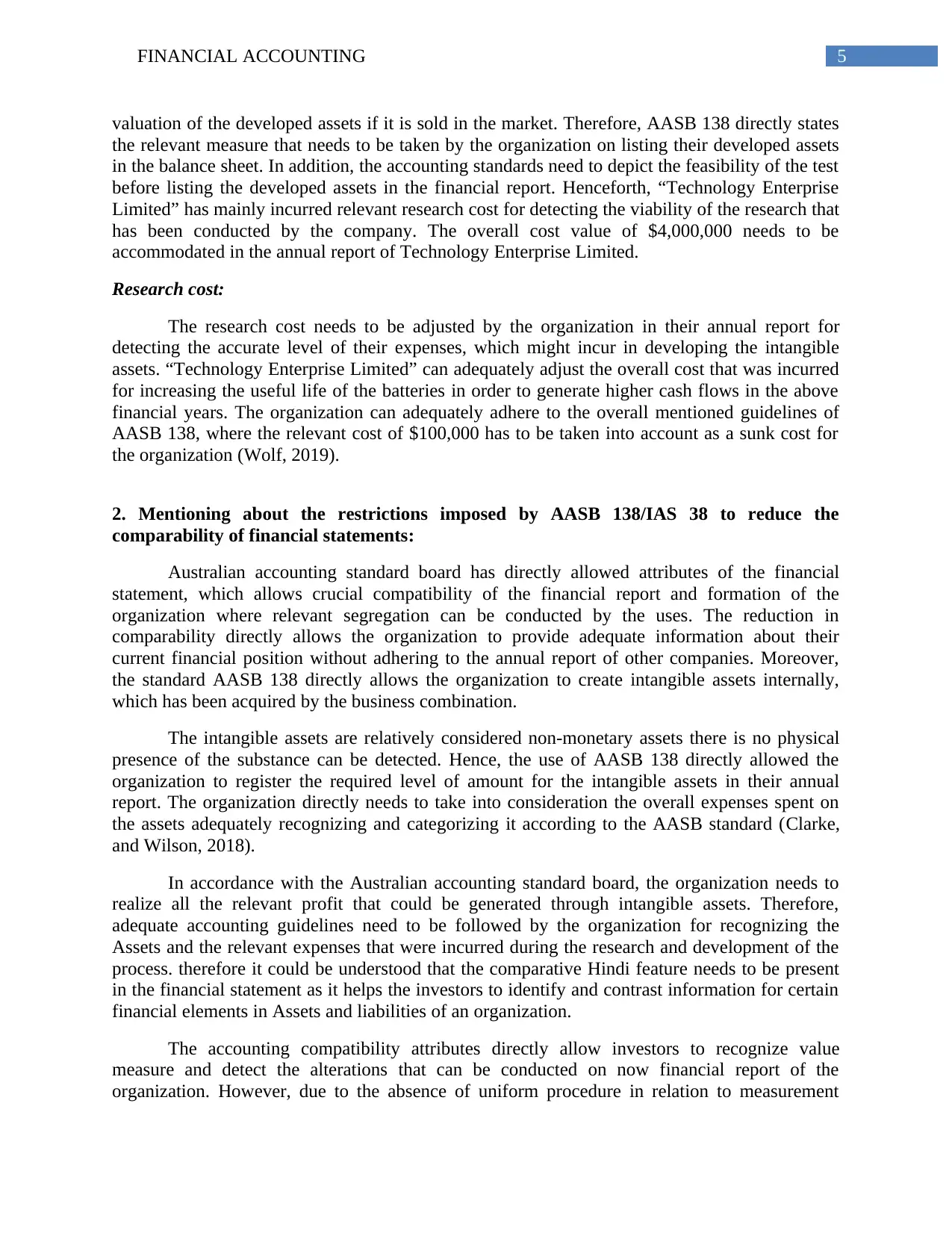
5FINANCIAL ACCOUNTING
valuation of the developed assets if it is sold in the market. Therefore, AASB 138 directly states
the relevant measure that needs to be taken by the organization on listing their developed assets
in the balance sheet. In addition, the accounting standards need to depict the feasibility of the test
before listing the developed assets in the financial report. Henceforth, “Technology Enterprise
Limited” has mainly incurred relevant research cost for detecting the viability of the research that
has been conducted by the company. The overall cost value of $4,000,000 needs to be
accommodated in the annual report of Technology Enterprise Limited.
Research cost:
The research cost needs to be adjusted by the organization in their annual report for
detecting the accurate level of their expenses, which might incur in developing the intangible
assets. “Technology Enterprise Limited” can adequately adjust the overall cost that was incurred
for increasing the useful life of the batteries in order to generate higher cash flows in the above
financial years. The organization can adequately adhere to the overall mentioned guidelines of
AASB 138, where the relevant cost of $100,000 has to be taken into account as a sunk cost for
the organization (Wolf, 2019).
2. Mentioning about the restrictions imposed by AASB 138/IAS 38 to reduce the
comparability of financial statements:
Australian accounting standard board has directly allowed attributes of the financial
statement, which allows crucial compatibility of the financial report and formation of the
organization where relevant segregation can be conducted by the uses. The reduction in
comparability directly allows the organization to provide adequate information about their
current financial position without adhering to the annual report of other companies. Moreover,
the standard AASB 138 directly allows the organization to create intangible assets internally,
which has been acquired by the business combination.
The intangible assets are relatively considered non-monetary assets there is no physical
presence of the substance can be detected. Hence, the use of AASB 138 directly allowed the
organization to register the required level of amount for the intangible assets in their annual
report. The organization directly needs to take into consideration the overall expenses spent on
the assets adequately recognizing and categorizing it according to the AASB standard (Clarke,
and Wilson, 2018).
In accordance with the Australian accounting standard board, the organization needs to
realize all the relevant profit that could be generated through intangible assets. Therefore,
adequate accounting guidelines need to be followed by the organization for recognizing the
Assets and the relevant expenses that were incurred during the research and development of the
process. therefore it could be understood that the comparative Hindi feature needs to be present
in the financial statement as it helps the investors to identify and contrast information for certain
financial elements in Assets and liabilities of an organization.
The accounting compatibility attributes directly allow investors to recognize value
measure and detect the alterations that can be conducted on now financial report of the
organization. However, due to the absence of uniform procedure in relation to measurement
valuation of the developed assets if it is sold in the market. Therefore, AASB 138 directly states
the relevant measure that needs to be taken by the organization on listing their developed assets
in the balance sheet. In addition, the accounting standards need to depict the feasibility of the test
before listing the developed assets in the financial report. Henceforth, “Technology Enterprise
Limited” has mainly incurred relevant research cost for detecting the viability of the research that
has been conducted by the company. The overall cost value of $4,000,000 needs to be
accommodated in the annual report of Technology Enterprise Limited.
Research cost:
The research cost needs to be adjusted by the organization in their annual report for
detecting the accurate level of their expenses, which might incur in developing the intangible
assets. “Technology Enterprise Limited” can adequately adjust the overall cost that was incurred
for increasing the useful life of the batteries in order to generate higher cash flows in the above
financial years. The organization can adequately adhere to the overall mentioned guidelines of
AASB 138, where the relevant cost of $100,000 has to be taken into account as a sunk cost for
the organization (Wolf, 2019).
2. Mentioning about the restrictions imposed by AASB 138/IAS 38 to reduce the
comparability of financial statements:
Australian accounting standard board has directly allowed attributes of the financial
statement, which allows crucial compatibility of the financial report and formation of the
organization where relevant segregation can be conducted by the uses. The reduction in
comparability directly allows the organization to provide adequate information about their
current financial position without adhering to the annual report of other companies. Moreover,
the standard AASB 138 directly allows the organization to create intangible assets internally,
which has been acquired by the business combination.
The intangible assets are relatively considered non-monetary assets there is no physical
presence of the substance can be detected. Hence, the use of AASB 138 directly allowed the
organization to register the required level of amount for the intangible assets in their annual
report. The organization directly needs to take into consideration the overall expenses spent on
the assets adequately recognizing and categorizing it according to the AASB standard (Clarke,
and Wilson, 2018).
In accordance with the Australian accounting standard board, the organization needs to
realize all the relevant profit that could be generated through intangible assets. Therefore,
adequate accounting guidelines need to be followed by the organization for recognizing the
Assets and the relevant expenses that were incurred during the research and development of the
process. therefore it could be understood that the comparative Hindi feature needs to be present
in the financial statement as it helps the investors to identify and contrast information for certain
financial elements in Assets and liabilities of an organization.
The accounting compatibility attributes directly allow investors to recognize value
measure and detect the alterations that can be conducted on now financial report of the
organization. However, due to the absence of uniform procedure in relation to measurement
⊘ This is a preview!⊘
Do you want full access?
Subscribe today to unlock all pages.

Trusted by 1+ million students worldwide
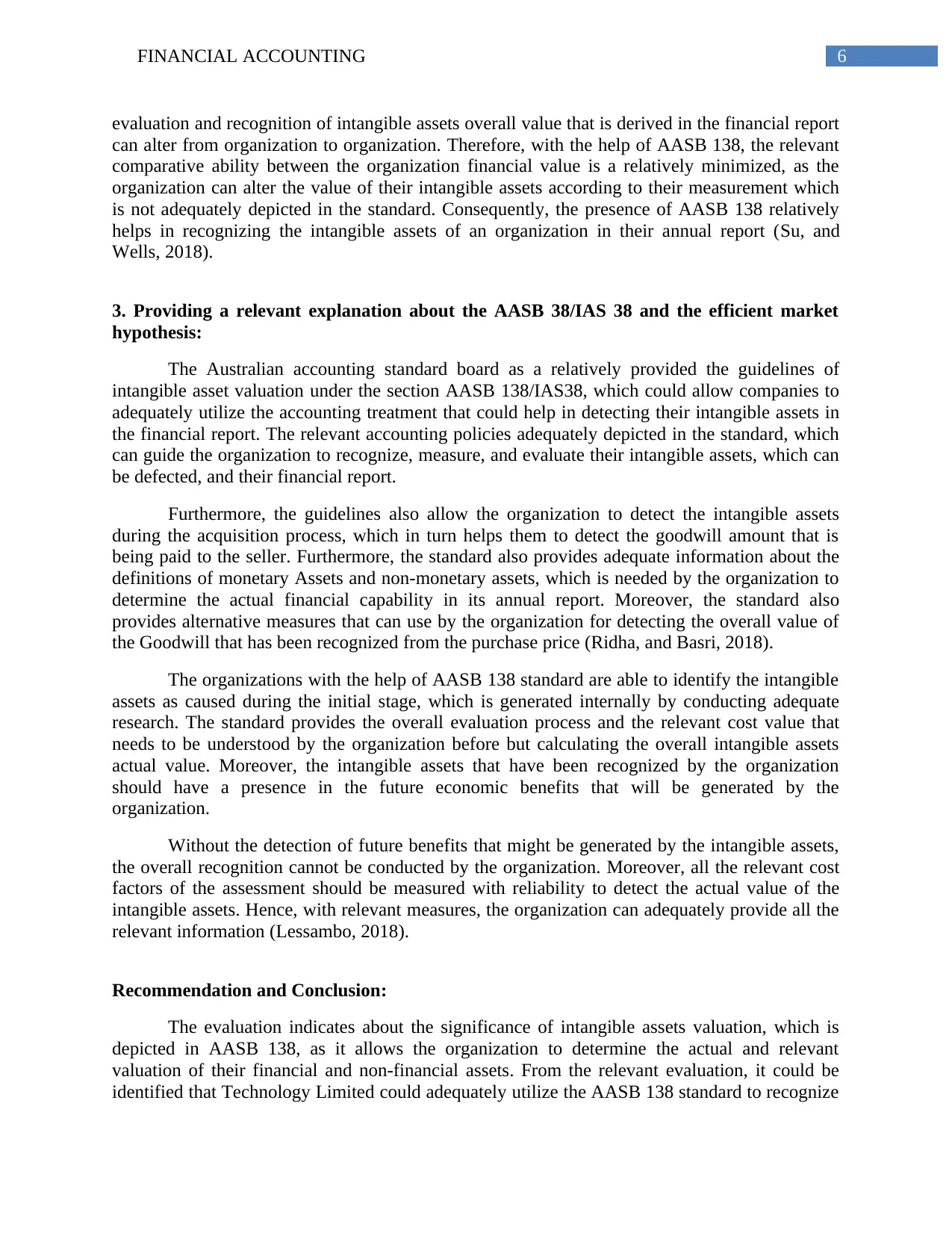
6FINANCIAL ACCOUNTING
evaluation and recognition of intangible assets overall value that is derived in the financial report
can alter from organization to organization. Therefore, with the help of AASB 138, the relevant
comparative ability between the organization financial value is a relatively minimized, as the
organization can alter the value of their intangible assets according to their measurement which
is not adequately depicted in the standard. Consequently, the presence of AASB 138 relatively
helps in recognizing the intangible assets of an organization in their annual report (Su, and
Wells, 2018).
3. Providing a relevant explanation about the AASB 38/IAS 38 and the efficient market
hypothesis:
The Australian accounting standard board as a relatively provided the guidelines of
intangible asset valuation under the section AASB 138/IAS38, which could allow companies to
adequately utilize the accounting treatment that could help in detecting their intangible assets in
the financial report. The relevant accounting policies adequately depicted in the standard, which
can guide the organization to recognize, measure, and evaluate their intangible assets, which can
be defected, and their financial report.
Furthermore, the guidelines also allow the organization to detect the intangible assets
during the acquisition process, which in turn helps them to detect the goodwill amount that is
being paid to the seller. Furthermore, the standard also provides adequate information about the
definitions of monetary Assets and non-monetary assets, which is needed by the organization to
determine the actual financial capability in its annual report. Moreover, the standard also
provides alternative measures that can use by the organization for detecting the overall value of
the Goodwill that has been recognized from the purchase price (Ridha, and Basri, 2018).
The organizations with the help of AASB 138 standard are able to identify the intangible
assets as caused during the initial stage, which is generated internally by conducting adequate
research. The standard provides the overall evaluation process and the relevant cost value that
needs to be understood by the organization before but calculating the overall intangible assets
actual value. Moreover, the intangible assets that have been recognized by the organization
should have a presence in the future economic benefits that will be generated by the
organization.
Without the detection of future benefits that might be generated by the intangible assets,
the overall recognition cannot be conducted by the organization. Moreover, all the relevant cost
factors of the assessment should be measured with reliability to detect the actual value of the
intangible assets. Hence, with relevant measures, the organization can adequately provide all the
relevant information (Lessambo, 2018).
Recommendation and Conclusion:
The evaluation indicates about the significance of intangible assets valuation, which is
depicted in AASB 138, as it allows the organization to determine the actual and relevant
valuation of their financial and non-financial assets. From the relevant evaluation, it could be
identified that Technology Limited could adequately utilize the AASB 138 standard to recognize
evaluation and recognition of intangible assets overall value that is derived in the financial report
can alter from organization to organization. Therefore, with the help of AASB 138, the relevant
comparative ability between the organization financial value is a relatively minimized, as the
organization can alter the value of their intangible assets according to their measurement which
is not adequately depicted in the standard. Consequently, the presence of AASB 138 relatively
helps in recognizing the intangible assets of an organization in their annual report (Su, and
Wells, 2018).
3. Providing a relevant explanation about the AASB 38/IAS 38 and the efficient market
hypothesis:
The Australian accounting standard board as a relatively provided the guidelines of
intangible asset valuation under the section AASB 138/IAS38, which could allow companies to
adequately utilize the accounting treatment that could help in detecting their intangible assets in
the financial report. The relevant accounting policies adequately depicted in the standard, which
can guide the organization to recognize, measure, and evaluate their intangible assets, which can
be defected, and their financial report.
Furthermore, the guidelines also allow the organization to detect the intangible assets
during the acquisition process, which in turn helps them to detect the goodwill amount that is
being paid to the seller. Furthermore, the standard also provides adequate information about the
definitions of monetary Assets and non-monetary assets, which is needed by the organization to
determine the actual financial capability in its annual report. Moreover, the standard also
provides alternative measures that can use by the organization for detecting the overall value of
the Goodwill that has been recognized from the purchase price (Ridha, and Basri, 2018).
The organizations with the help of AASB 138 standard are able to identify the intangible
assets as caused during the initial stage, which is generated internally by conducting adequate
research. The standard provides the overall evaluation process and the relevant cost value that
needs to be understood by the organization before but calculating the overall intangible assets
actual value. Moreover, the intangible assets that have been recognized by the organization
should have a presence in the future economic benefits that will be generated by the
organization.
Without the detection of future benefits that might be generated by the intangible assets,
the overall recognition cannot be conducted by the organization. Moreover, all the relevant cost
factors of the assessment should be measured with reliability to detect the actual value of the
intangible assets. Hence, with relevant measures, the organization can adequately provide all the
relevant information (Lessambo, 2018).
Recommendation and Conclusion:
The evaluation indicates about the significance of intangible assets valuation, which is
depicted in AASB 138, as it allows the organization to determine the actual and relevant
valuation of their financial and non-financial assets. From the relevant evaluation, it could be
identified that Technology Limited could adequately utilize the AASB 138 standard to recognize
Paraphrase This Document
Need a fresh take? Get an instant paraphrase of this document with our AI Paraphraser
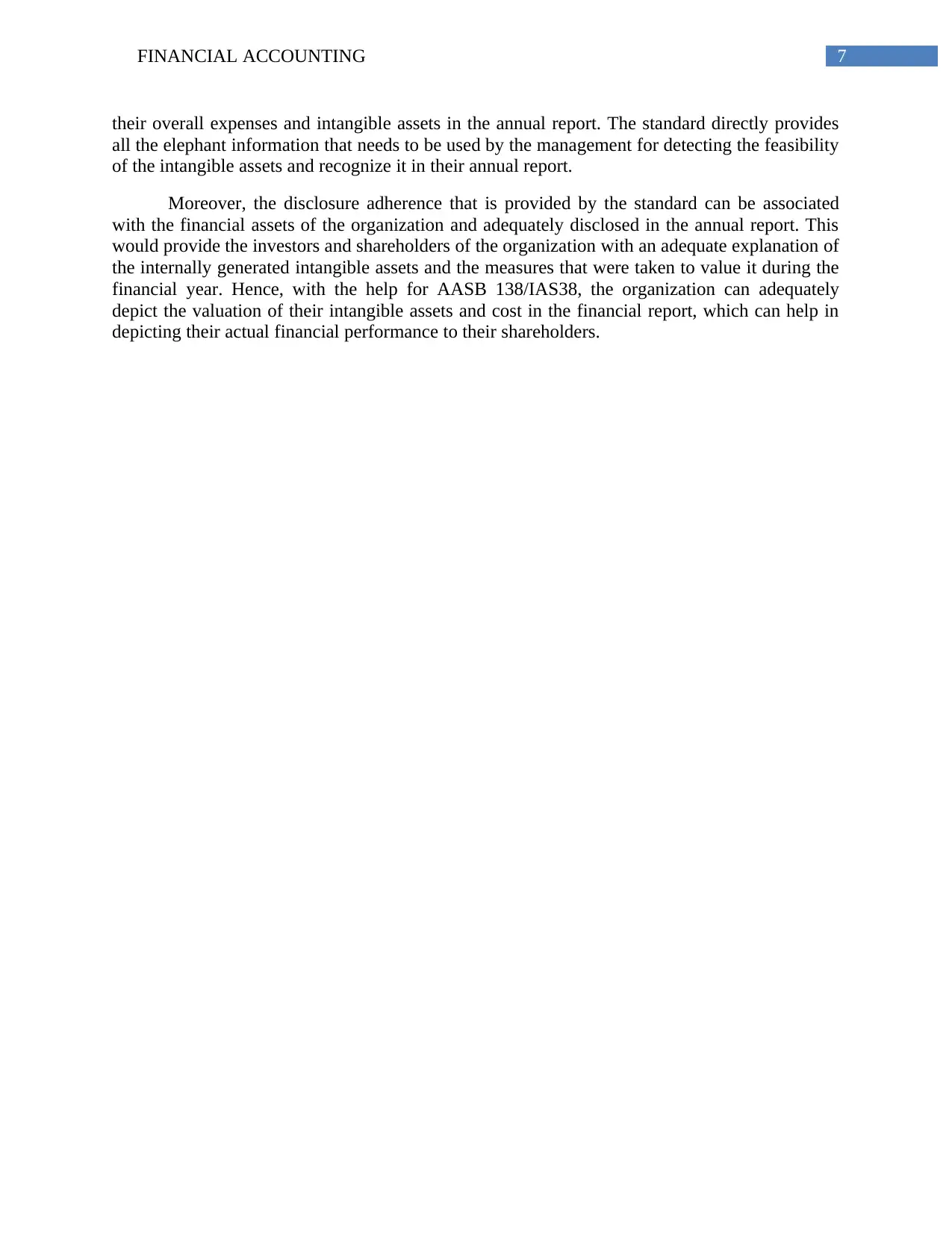
7FINANCIAL ACCOUNTING
their overall expenses and intangible assets in the annual report. The standard directly provides
all the elephant information that needs to be used by the management for detecting the feasibility
of the intangible assets and recognize it in their annual report.
Moreover, the disclosure adherence that is provided by the standard can be associated
with the financial assets of the organization and adequately disclosed in the annual report. This
would provide the investors and shareholders of the organization with an adequate explanation of
the internally generated intangible assets and the measures that were taken to value it during the
financial year. Hence, with the help for AASB 138/IAS38, the organization can adequately
depict the valuation of their intangible assets and cost in the financial report, which can help in
depicting their actual financial performance to their shareholders.
their overall expenses and intangible assets in the annual report. The standard directly provides
all the elephant information that needs to be used by the management for detecting the feasibility
of the intangible assets and recognize it in their annual report.
Moreover, the disclosure adherence that is provided by the standard can be associated
with the financial assets of the organization and adequately disclosed in the annual report. This
would provide the investors and shareholders of the organization with an adequate explanation of
the internally generated intangible assets and the measures that were taken to value it during the
financial year. Hence, with the help for AASB 138/IAS38, the organization can adequately
depict the valuation of their intangible assets and cost in the financial report, which can help in
depicting their actual financial performance to their shareholders.
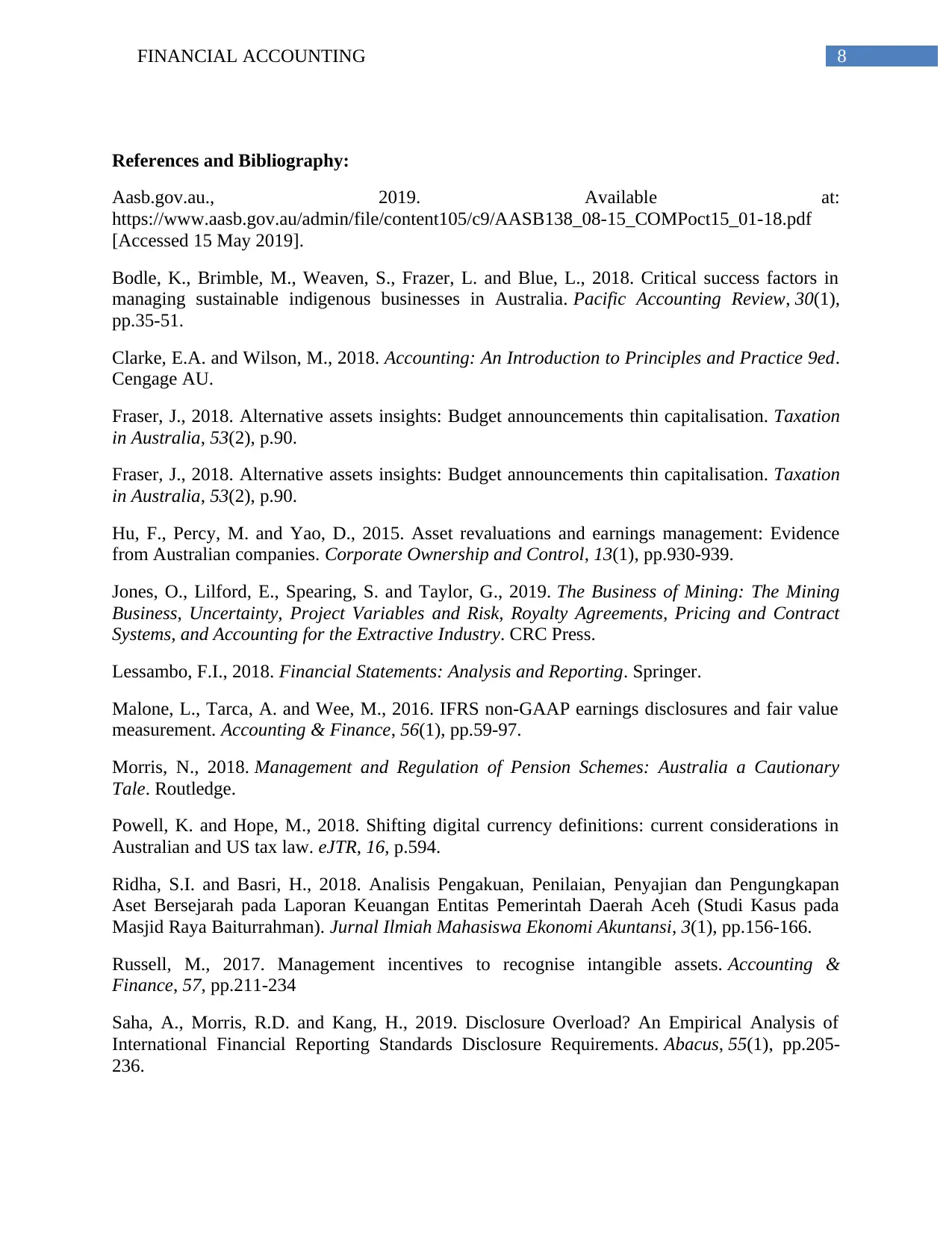
8FINANCIAL ACCOUNTING
References and Bibliography:
Aasb.gov.au., 2019. Available at:
https://www.aasb.gov.au/admin/file/content105/c9/AASB138_08-15_COMPoct15_01-18.pdf
[Accessed 15 May 2019].
Bodle, K., Brimble, M., Weaven, S., Frazer, L. and Blue, L., 2018. Critical success factors in
managing sustainable indigenous businesses in Australia. Pacific Accounting Review, 30(1),
pp.35-51.
Clarke, E.A. and Wilson, M., 2018. Accounting: An Introduction to Principles and Practice 9ed.
Cengage AU.
Fraser, J., 2018. Alternative assets insights: Budget announcements thin capitalisation. Taxation
in Australia, 53(2), p.90.
Fraser, J., 2018. Alternative assets insights: Budget announcements thin capitalisation. Taxation
in Australia, 53(2), p.90.
Hu, F., Percy, M. and Yao, D., 2015. Asset revaluations and earnings management: Evidence
from Australian companies. Corporate Ownership and Control, 13(1), pp.930-939.
Jones, O., Lilford, E., Spearing, S. and Taylor, G., 2019. The Business of Mining: The Mining
Business, Uncertainty, Project Variables and Risk, Royalty Agreements, Pricing and Contract
Systems, and Accounting for the Extractive Industry. CRC Press.
Lessambo, F.I., 2018. Financial Statements: Analysis and Reporting. Springer.
Malone, L., Tarca, A. and Wee, M., 2016. IFRS non‐GAAP earnings disclosures and fair value
measurement. Accounting & Finance, 56(1), pp.59-97.
Morris, N., 2018. Management and Regulation of Pension Schemes: Australia a Cautionary
Tale. Routledge.
Powell, K. and Hope, M., 2018. Shifting digital currency definitions: current considerations in
Australian and US tax law. eJTR, 16, p.594.
Ridha, S.I. and Basri, H., 2018. Analisis Pengakuan, Penilaian, Penyajian dan Pengungkapan
Aset Bersejarah pada Laporan Keuangan Entitas Pemerintah Daerah Aceh (Studi Kasus pada
Masjid Raya Baiturrahman). Jurnal Ilmiah Mahasiswa Ekonomi Akuntansi, 3(1), pp.156-166.
Russell, M., 2017. Management incentives to recognise intangible assets. Accounting &
Finance, 57, pp.211-234
Saha, A., Morris, R.D. and Kang, H., 2019. Disclosure Overload? An Empirical Analysis of
International Financial Reporting Standards Disclosure Requirements. Abacus, 55(1), pp.205-
236.
References and Bibliography:
Aasb.gov.au., 2019. Available at:
https://www.aasb.gov.au/admin/file/content105/c9/AASB138_08-15_COMPoct15_01-18.pdf
[Accessed 15 May 2019].
Bodle, K., Brimble, M., Weaven, S., Frazer, L. and Blue, L., 2018. Critical success factors in
managing sustainable indigenous businesses in Australia. Pacific Accounting Review, 30(1),
pp.35-51.
Clarke, E.A. and Wilson, M., 2018. Accounting: An Introduction to Principles and Practice 9ed.
Cengage AU.
Fraser, J., 2018. Alternative assets insights: Budget announcements thin capitalisation. Taxation
in Australia, 53(2), p.90.
Fraser, J., 2018. Alternative assets insights: Budget announcements thin capitalisation. Taxation
in Australia, 53(2), p.90.
Hu, F., Percy, M. and Yao, D., 2015. Asset revaluations and earnings management: Evidence
from Australian companies. Corporate Ownership and Control, 13(1), pp.930-939.
Jones, O., Lilford, E., Spearing, S. and Taylor, G., 2019. The Business of Mining: The Mining
Business, Uncertainty, Project Variables and Risk, Royalty Agreements, Pricing and Contract
Systems, and Accounting for the Extractive Industry. CRC Press.
Lessambo, F.I., 2018. Financial Statements: Analysis and Reporting. Springer.
Malone, L., Tarca, A. and Wee, M., 2016. IFRS non‐GAAP earnings disclosures and fair value
measurement. Accounting & Finance, 56(1), pp.59-97.
Morris, N., 2018. Management and Regulation of Pension Schemes: Australia a Cautionary
Tale. Routledge.
Powell, K. and Hope, M., 2018. Shifting digital currency definitions: current considerations in
Australian and US tax law. eJTR, 16, p.594.
Ridha, S.I. and Basri, H., 2018. Analisis Pengakuan, Penilaian, Penyajian dan Pengungkapan
Aset Bersejarah pada Laporan Keuangan Entitas Pemerintah Daerah Aceh (Studi Kasus pada
Masjid Raya Baiturrahman). Jurnal Ilmiah Mahasiswa Ekonomi Akuntansi, 3(1), pp.156-166.
Russell, M., 2017. Management incentives to recognise intangible assets. Accounting &
Finance, 57, pp.211-234
Saha, A., Morris, R.D. and Kang, H., 2019. Disclosure Overload? An Empirical Analysis of
International Financial Reporting Standards Disclosure Requirements. Abacus, 55(1), pp.205-
236.
⊘ This is a preview!⊘
Do you want full access?
Subscribe today to unlock all pages.

Trusted by 1+ million students worldwide
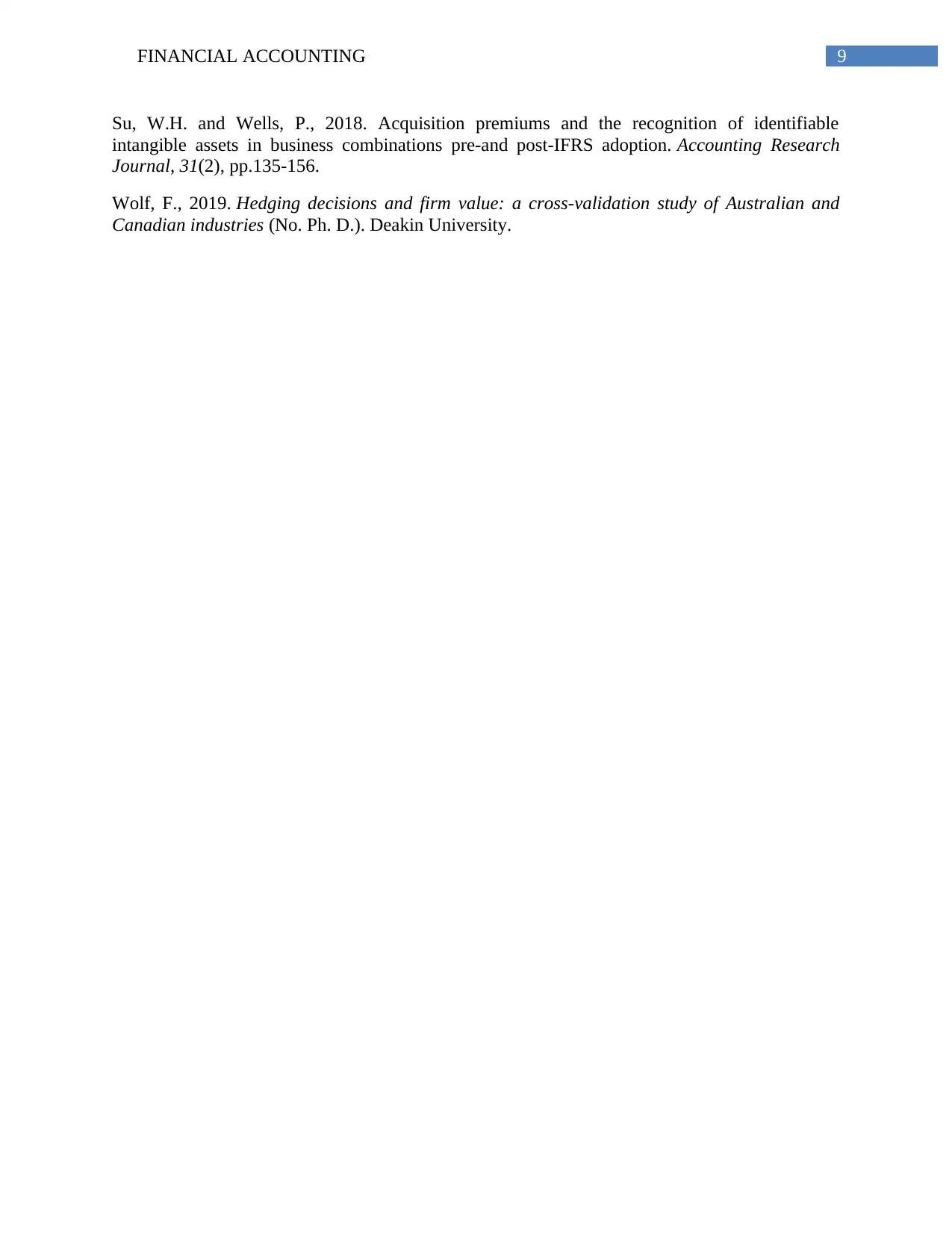
9FINANCIAL ACCOUNTING
Su, W.H. and Wells, P., 2018. Acquisition premiums and the recognition of identifiable
intangible assets in business combinations pre-and post-IFRS adoption. Accounting Research
Journal, 31(2), pp.135-156.
Wolf, F., 2019. Hedging decisions and firm value: a cross-validation study of Australian and
Canadian industries (No. Ph. D.). Deakin University.
Su, W.H. and Wells, P., 2018. Acquisition premiums and the recognition of identifiable
intangible assets in business combinations pre-and post-IFRS adoption. Accounting Research
Journal, 31(2), pp.135-156.
Wolf, F., 2019. Hedging decisions and firm value: a cross-validation study of Australian and
Canadian industries (No. Ph. D.). Deakin University.
1 out of 10
Related Documents
Your All-in-One AI-Powered Toolkit for Academic Success.
+13062052269
info@desklib.com
Available 24*7 on WhatsApp / Email
![[object Object]](/_next/static/media/star-bottom.7253800d.svg)
Unlock your academic potential
Copyright © 2020–2025 A2Z Services. All Rights Reserved. Developed and managed by ZUCOL.





